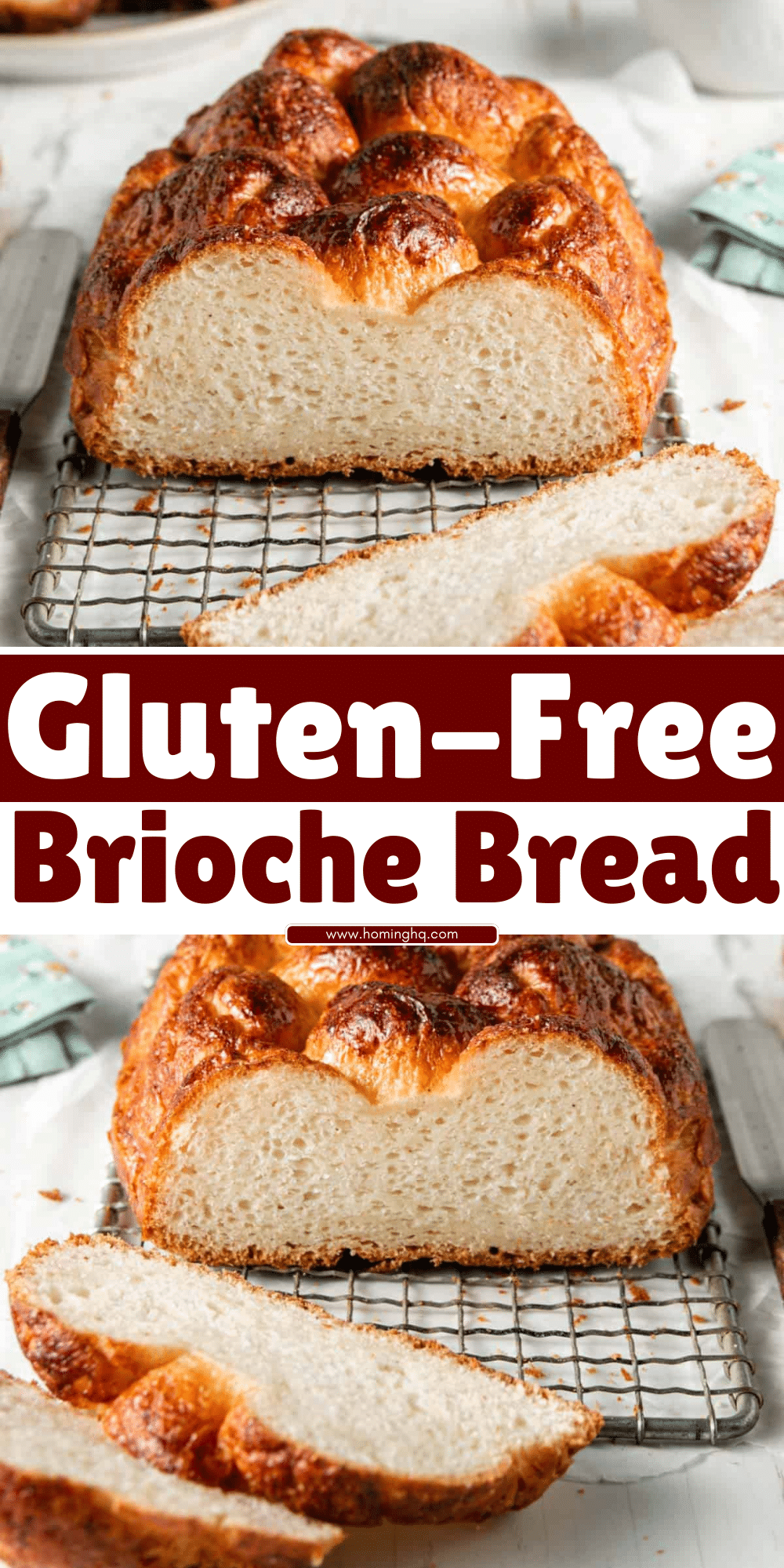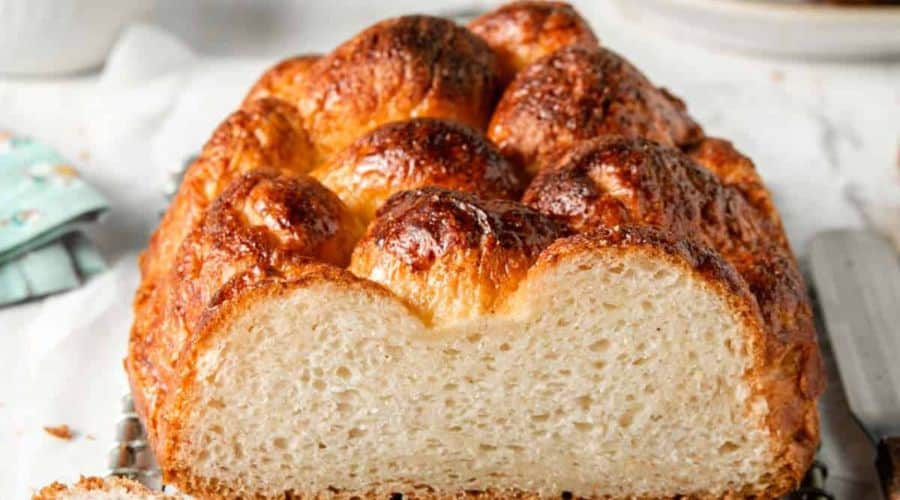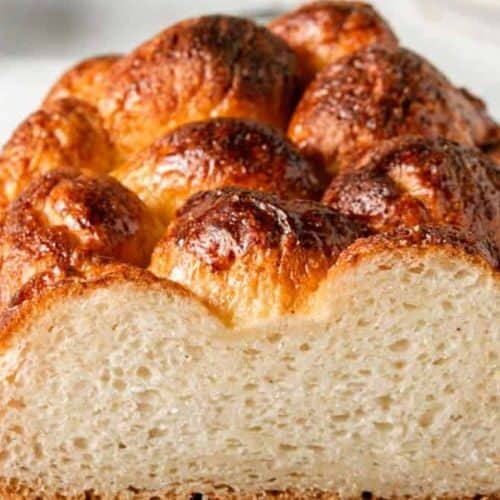All products are selected by our editorial team for quality. If you buy through our links, we may earn a small commission at no extra cost to you.
Brioche bread, known for its soft, airy texture and slightly sweet flavor, is a popular French bread that is loved by many.
Traditionally made with wheat flour, eggs, butter, and yeast, it is rich and indulgent, often used for everything from breakfast to dessert.
However, for those with gluten sensitivities or dietary restrictions, enjoying a warm slice of brioche can be challenging.
The good news is that gluten-free brioche bread offers a delightful alternative.
This version maintains the signature buttery richness and delicate crumb of the classic, all without the gluten.

What Is Brioche Bread?
Brioche bread is a type of French yeast bread that stands out for its rich texture and slightly sweet taste.
The dough is made with a high proportion of butter, eggs, and sometimes milk, which creates a soft and fluffy loaf.
Brioche can be used in a variety of dishes, such as French toast, sandwiches, or simply enjoyed on its own with a spread of jam or butter. The bread is typically light, slightly golden, and has a crumb that is airy yet rich in flavor.
Why Make Gluten-Free Brioche Bread?
Making gluten-free brioche bread is essential for those with gluten intolerance or celiac disease, as it allows them to enjoy a classic treat without any adverse health effects.
Additionally, many people are choosing gluten-free diets for a variety of reasons, including digestion issues or a desire for a healthier lifestyle.
With gluten-free brioche, individuals can still savor the deliciously buttery and soft texture of the traditional brioche, while adhering to their dietary preferences or restrictions.
Furthermore, gluten-free brioche bread offers an excellent option for anyone looking to explore new baking techniques or challenge their skills.
It also opens up the possibility for those following other dietary needs, such as dairy-free or vegan, to adapt the recipe to suit their specific preferences.
Key Ingredients for Gluten-Free Brioche Bread
To make gluten-free brioche bread, you’ll need a specific set of ingredients that can replicate the texture and flavor of traditional brioche without the use of gluten.
These ingredients are crucial for achieving the rich, soft texture and subtle sweetness that brioche is known for:
- Gluten-Free Flour Blend: A combination of different gluten-free flours (such as rice flour, tapioca flour, or sorghum flour) will provide structure and elasticity.
- Butter or Dairy-Free Butter: Butter is key to brioche’s rich flavor and soft texture. For a dairy-free version, a non-dairy alternative can be used.
- Eggs: Eggs give the bread its soft and airy texture while contributing to the richness of the flavor.
- Yeast: Yeast is essential for making the bread rise and gives it its characteristic fluffiness.
- Sugar: A small amount of sugar helps activate the yeast and provides a subtle sweetness to balance the richness of the butter.
- Milk or Dairy-Free Milk: Milk helps to create a soft, tender crumb. Use a dairy-free version if needed.
- Salt: Salt enhances the overall flavor and balances the sweetness of the bread.
Tools Needed for Gluten-Free Brioche
To successfully make gluten-free brioche bread, you’ll need the following tools:
- Mixing Bowl: A large bowl for mixing the dough and ensuring all the ingredients are well incorporated.
- Stand Mixer or Hand Mixer: A stand mixer can make the kneading process easier, especially when working with gluten-free dough, which tends to be stickier than traditional dough.
- Measuring Cups and Spoons: Accurate measurements are essential when working with gluten-free ingredients.
- Loaf Pan or Brioche Pan: A loaf pan will work for traditional brioche, while a brioche pan can give it that signature round shape.
- Plastic Wrap or Damp Towel: To cover the dough as it rises, preventing it from drying out.
- Cooling Rack: To allow the bread to cool evenly once baked, preventing it from becoming soggy.
These tools, combined with the right ingredients, will help you create a beautiful and delicious loaf of gluten-free brioche.
Step-by-Step Instructions for Making Gluten-Free Brioche Bread

Making gluten-free brioche bread might seem intimidating, but with a few simple steps, you can create a soft, buttery loaf that rivals the traditional version.
Here’s a step-by-step guide to help you through the process:
1. Prepare Your Ingredients
Before you begin, gather all the ingredients listed in the “Key Ingredients for Gluten-Free Brioche Bread” section.
Make sure your yeast is fresh and your ingredients are at room temperature to ensure a smooth dough.
2. Activate the Yeast
In a small bowl, combine warm milk (or dairy-free milk) and sugar. Sprinkle the yeast over the top and stir gently.
Let the mixture sit for about 5-10 minutes until it becomes frothy.
This process activates the yeast, ensuring that your bread will rise properly.
3. Mix the Dry Ingredients
In a separate large mixing bowl, whisk together the gluten-free flour blend and salt.
It’s important to make sure the flour is well-mixed to avoid any pockets of salt or flour in the dough.
4. Combine Wet Ingredients
In another bowl, beat the eggs and melted butter (or dairy-free butter). Once the yeast mixture is frothy, add it to the wet ingredients and mix until well combined.
5. Form the Dough
Gradually add the wet ingredients into the dry ingredients, mixing with a wooden spoon or a hand mixer until a sticky dough forms. The dough for gluten-free brioche tends to be wetter and stickier than traditional brioche, so don’t worry if it’s not as firm as you expect.
6. Knead the Dough
If using a stand mixer, attach the dough hook and knead the dough on low speed for about 5-7 minutes.
If you’re kneading by hand, lightly oil your hands and gently knead the dough in the bowl for a few minutes, until it comes together.
The dough will remain sticky, so use a spatula to scrape the sides of the bowl as needed.
7. Let the Dough Rise
Transfer the dough to a greased bowl and cover it with plastic wrap or a damp towel.
Let the dough rise in a warm, draft-free area for 1-2 hours, or until it has doubled in size.
Gluten-free dough can take a little longer to rise than traditional dough, so be patient.
8. Shape the Dough
Once the dough has risen, gently punch it down to release the air.
Turn the dough out onto a lightly floured surface (using gluten-free flour) and shape it into a ball or a loaf, depending on the pan you’re using.
If you’re using a brioche pan, place the dough into the greased pan.
9. Second Rise
Cover the shaped dough with a towel or plastic wrap and let it rise again for 30-60 minutes, until it has risen slightly above the pan edges.
This second rise helps create a light, airy texture.
10. Bake the Brioche
Preheat your oven to 350°F (175°C). Once the dough has risen, place it in the oven and bake for 30-40 minutes, or until the top is golden brown and the loaf sounds hollow when tapped on the bottom.
You can also check the internal temperature; it should be about 200°F (93°C).
11. Cool the Bread
Remove the brioche from the oven and allow it to cool in the pan for about 10 minutes.
Then, transfer the bread to a cooling rack to cool completely before slicing.
This helps prevent the bread from becoming too dense or soggy.
Storing and Serving Your Gluten-Free Brioche Bread
Storing Gluten-Free Brioche Bread
- Room Temperature: Gluten-free brioche bread can be stored at room temperature for 2-3 days in an airtight container or wrapped in plastic wrap. This will help retain its freshness and moisture.
- Freezing: If you want to store the bread for a longer period, freeze it after it has cooled completely. Wrap the loaf in plastic wrap and aluminum foil, or place it in a freezer bag. When you’re ready to enjoy it, simply thaw at room temperature, or warm it up in the oven for a few minutes.
- Refrigeration: While refrigeration can extend the shelf life of gluten-free bread, it may cause it to dry out. If you do refrigerate, be sure to wrap it tightly to minimize moisture loss.
Serving Gluten-Free Brioche Bread
Gluten-free brioche bread can be served in various ways, depending on your preference:
- Toast: Slice and toast the bread for a crispy, golden exterior. Spread with butter or your favorite jam for a classic treat.
- French Toast: Brioche makes an excellent base for French toast. Its airy texture soaks up the egg mixture beautifully, resulting in a deliciously soft and indulgent breakfast.
- Sandwiches: Use the bread to make soft, buttery sandwiches with your choice of fillings—whether it’s savory or sweet.
- Desserts: Gluten-free brioche is also perfect for desserts like bread pudding or as a base for decadent desserts like brioche bread and butter pudding.
By following these storage and serving tips, you can enjoy your gluten-free brioche bread fresh and delicious for days to come.
Conclusion
Making gluten-free brioche bread is an enjoyable and rewarding experience for those with dietary restrictions or anyone looking to explore a new baking challenge.
By following the right steps and using high-quality ingredients, you can create a soft, buttery, and flavorful loaf that mimics the traditional brioche without the use of gluten.
Whether you’re using it for sandwiches, French toast, or simply enjoying it as-is, gluten-free brioche is a versatile and delightful bread that everyone can enjoy.
With proper storage, it stays fresh for several days, allowing you to savor each slice at your leisure.
Frequently Asked Questions
1. Can I use any gluten-free flour for this recipe?
While you can experiment with different gluten-free flour blends, it’s important to use a well-balanced flour blend that contains a mix of rice flour, tapioca flour, and sorghum flour.
This will give you the right texture and elasticity. Avoid using single flours like almond flour, as they may result in a denser loaf.
2. Can I make this recipe dairy-free?
Yes, you can easily make gluten-free brioche dairy-free by using non-dairy butter and milk alternatives, such as almond milk or coconut milk.
The texture and flavor will remain rich and delicious.
3. How can I make the brioche more flavorful?
You can enhance the flavor of your gluten-free brioche by adding a teaspoon of vanilla extract or a pinch of cinnamon.
You could also mix in citrus zest, such as lemon or orange, for a fresh twist.
4. Why is my gluten-free brioche dense?
If your gluten-free brioche turns out dense, it may be due to under-proofing or overworking the dough.
Ensure you allow enough time for the dough to rise, and avoid over-kneading.
Gluten-free dough is more fragile and can easily become dense if not handled gently.
5. Can I freeze gluten-free brioche bread?
Yes, you can freeze gluten-free brioche bread.
After the bread has cooled completely, wrap it tightly in plastic wrap and foil, then place it in a freezer bag. It can be frozen for up to 3 months.
When ready to enjoy, let it thaw at room temperature or warm it up in the oven for the best texture.

Gluten-Free Brioche Bread
Equipment
- Mixing bowl (1, large)
- Stand Mixer or Hand Mixer (1)
- Measuring cups (1 set)
- Measuring spoons (1 set)
- Loaf Pan or Brioche Pan (1, greased)
- Plastic Wrap or Damp Towel (1)
- Cooling rack (1)
Ingredients
- 2 1/2 cups 300g Gluten-Free Flour Blend
- 1 tsp 5g Salt
- 1/4 cup 60ml Warm Milk (or dairy-free milk)
- 1 tbsp 15g Sugar
- 2 1/4 tsp 7g Active Dry Yeast
- 3 Large Eggs room temperature
- 1/2 cup 115g Butter (or dairy-free butter, melted)
- 1/4 cup 60ml Warm Water (for yeast activation)
Instructions
- Activate the Yeast: In a small bowl, mix the warm milk, sugar, and yeast. Stir gently and let sit for 5-10 minutes until the mixture is frothy.
- Mix Dry Ingredients: In a large bowl, whisk together the gluten-free flour blend and salt.
- Combine Wet Ingredients: In another bowl, beat the eggs and melted butter. Add the yeast mixture to the eggs and butter, and mix until combined.
- Form the Dough: Gradually add the wet ingredients into the dry ingredients. Mix until a sticky dough forms, using a hand mixer or stand mixer with a dough hook if necessary.
- Knead the Dough: Knead the dough on low speed for 5-7 minutes using a stand mixer or by hand for about 5 minutes until it comes together.
- Let the Dough Rise: Transfer the dough to a greased bowl, cover with plastic wrap or a damp towel, and allow it to rise in a warm place for 1-2 hours until it doubles in size.
- Shape the Dough: Punch down the dough and shape it into a loaf. Place it into a greased loaf pan or brioche pan.
- Second Rise: Let the dough rise again for 30-60 minutes until it slightly exceeds the pan edges.
- Bake the Brioche: Preheat the oven to 350°F (175°C). Bake for 30-40 minutes until the top is golden brown and the bread sounds hollow when tapped.
- Cool: Remove the bread from the oven, let it cool for 10 minutes in the pan, and then transfer to a cooling rack to cool completely before slicing.
Notes
- Yeast Activation: Ensure the milk is warm (around 110°F or 43°C) but not too hot to avoid killing the yeast.
- Flour Blend: Use a high-quality gluten-free flour blend that contains xanthan gum or guar gum for best results.
- Dairy-Free Version: Substitute the butter with a non-dairy butter alternative and use almond or coconut milk to make it fully dairy-free.
- Storage: This bread stays fresh at room temperature for up to 2-3 days when stored in an airtight container. For longer storage, freeze it for up to 3 months.
- Texture Tip: Gluten-free dough tends to be stickier than regular dough, so be patient while handling it. Don’t over-knead, and allow ample rising time.

